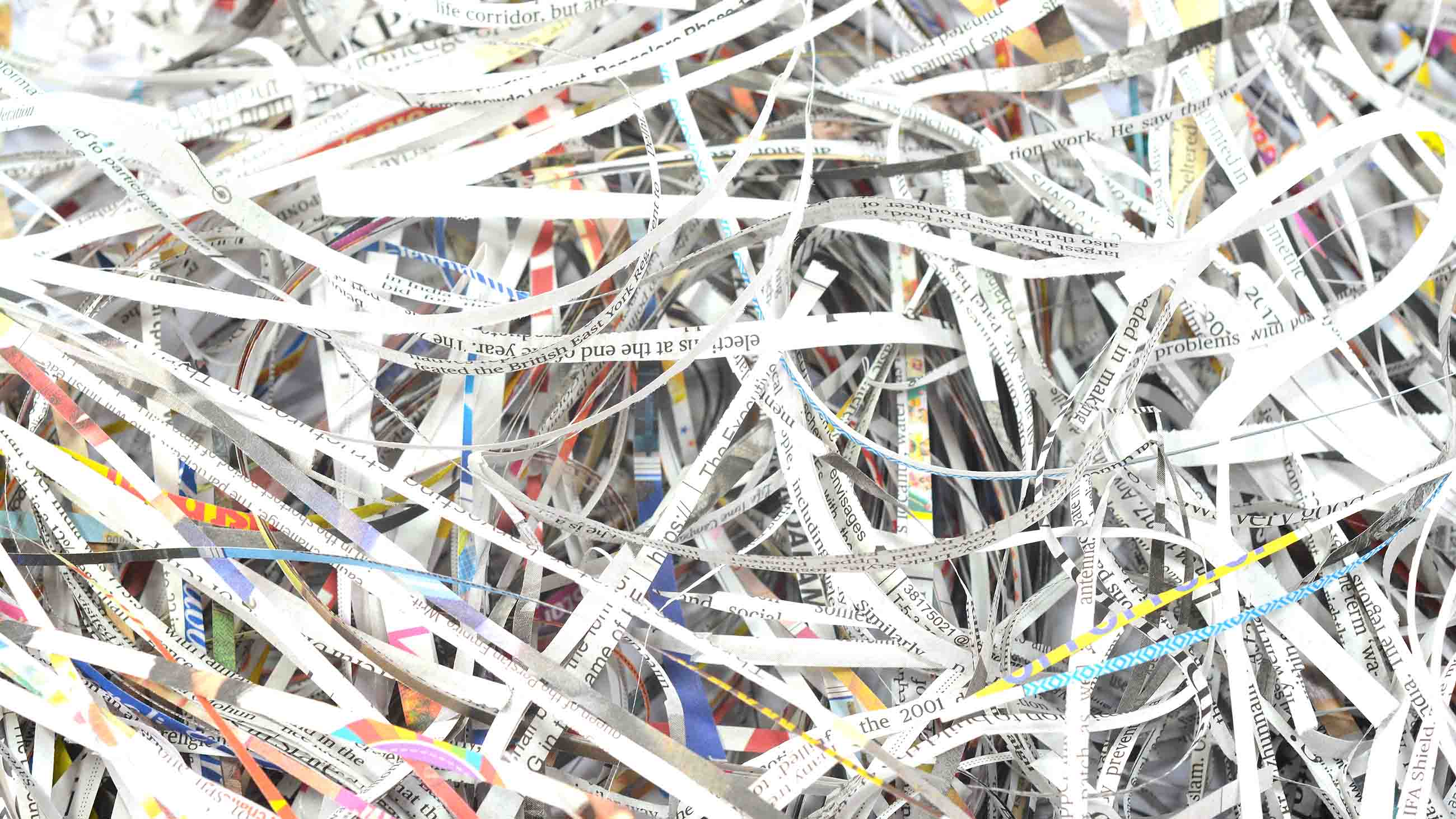A Request to Streamline Federal Document Purges Has Researchers on Edge
Last month, James R. Jacobs, the federal government information librarian at Stanford University Libraries, sent an alarmed message to a few library listservs: “I wanted to alert you to a very disturbing thing happening in the National Archives world that may severely impact research, especially historical and scientific research.”
The Department of the Interior (DOI), Jacobs added, was seeking “permission to destroy records about oil and gas leases, mining, dams, wells, timber sales, marine conservation, fishing, endangered species, non-endangered species, critical habitats, land acquisition, and lots more.”
The message spread among information specialists and government transparency advocates — and it was true: The DOI does plan to destroy potentially millions of documents dating back 50 years. Approval for the plan rests with the National Archives and Records Administration (NARA).
Of course, document archiving — and destruction — is routine at all federal agencies, and only between 1 and 3 percent of federal records are ever retained permanently. Maintenance typically follows a set schedule, whereby records — both digital and paper — are retained for a set period of time before being shredded, mulched, or, in the case of electronic documents, simply erased or made unreadable. In this case, however, the DOI is seeking permission from the National Archives to consolidate pre-existing schedules into what the National Archives calls “big buckets,” meaning requests for eliminating records could be made in larger groups.
The request was made more than two years ago, under the Obama administration, and officials from the DOI did not respond to multiple requests for comment. Still, some information specialists and government-transparency advocates say there are reasons for concern, including the potential for dubious classifications, a too-short retention schedule for some records, and an apparent tendency on the part of agency officials to protect records relating to economic development over other kinds of documents.
Another worry is that the record-keeping process may become overtly politicized, given the DOI’s additional request that authority for records destruction be shifted to the Office of the Secretary of the Interior, a political appointee. The current secretary, Ryan Zinke, has been the subject of three probes by the DOI’s own internal watchdog agency, one of which reportedly has been referred to the Justice Department.
The document purge also comes at a time of increasing high-level political interference in day-to-day operations of federal agencies and employees — especially scientists, whose work is documented in many of the records currently on the DOI chopping block.
The marked records come from all agencies within the DOI, including the United States Geological Survey, the Bureau of Land Management, the Bureau of Indian Affairs, and the Fish and Wildlife Service. About two-thirds are characterized as “temporary” and will be destroyed after a given time period, which can range from three to 75 years. The rest are deemed “permanent” and, in most cases, will be sent to NARA for storage.
No one seems to know exactly how many documents are involved, but NARA outreach specialist James Stossel calls it a “large volume.” Members of the public were allowed to send comments to NARA about the DOI’s request to NARA until November 26. In the past, “we have used these comments to work with the agencies to extend the proposed retention period or even to identify a records series as permanent,” says Stossel. The agency has already received hundreds of comments that “generally express concern that the Department of Interior is being authorized to dispose of any records.”
Due to the increased interest in this case, Stossel adds, NARA will discuss these comments with the DOI and require the agency “to make any needed changes to the schedule.” This process could take anywhere from a few days to several months, after which another 15-day public comment period will commence.
Jacobs, who is also a founder of Free Government Information, an online community dedicated to promoting access to government information, says the documents at risk include observational scientific data in endangered species recovery plans, critical habitat files, energy and minerals applications case files, and land use planning materials.
“This is data that once it’s destroyed,” he says, “you can’t replace it or re-create it.”
Government generates paperwork. When a federal agency wants to toss some of it — storage can be costly and take up a lot of space — it must ask for NARA’s approval with what’s called a record disposition authority request (also known as a records schedule). NARA then posts a notice on the Federal Register, a “daily journal” of the federal government’s activities, as it did with the new DOI proposal.
Russ Kick, a government transparency advocate and investigative archivist, asked NARA for the schedule and related documents, which he published on his website, AltGov2 on October 16.
Not everyone has found cause for worry. Ya-Wei Li, the director for biodiversity at the Environmental Policy Innovation Center, calls himself a “hoarder” of documents related to the Endangered Species Act. “I have submitted a lot of FOIA requests to [the] Fish and Wildlife Service over the years, and the categories for information that are proposed for destruction here are not ones that, to me, are high priorities for things that I would personally ask for to better understand government decisions.”
Jacobs, however, pored over the documents at the AltGov2 website and then compared notes with others. “I think I was justified in my concern,” Jacobs says.
Some records, for example, were found to have remarkably short retention policies. These include, for example, records related to sea lampreys — parasitic fish that wreaked havoc in the Great Lakes in the 20th century and continue to be a problem. A science-rich, decades-long effort to combat the invasion has seen some success, but according to a Fish and Wildlife Service records policy that’s been in place since at least 2006 — and echoed on the DOI schedule — sea lamprey data should be kept for just three years, reviewed annually, and destroyed “when no longer needed.”
“Three years is not even close to how long that data could be useful to somebody,” says Margaret Janz, a librarian at the University of Pennsylvania and a co-founder of Data Refuge, a government-data rescue effort.
Other records have confusing and even contradictory classifications. For example, one “temporary” file, slated to be kept for 75 years, documents “the data-gathering, analysis, and evaluation activities that are conducted to assess the validity of potential quantities of undiscovered oil and gas resources, natural gas, and other leasable minerals.” These records are labeled both as having “little to no research value,” but also as having “scientific worth” that can be “re-used to create other records.”
Though federal agencies set their own guidelines about record retention, part of the problem with the DOI’s document purge request may be how NARA decides what constitutes a valuable record. Stossel says NARA is following its appraisal policy, which emphasizes saving records that document “the rights of American citizens, the actions of federal officials, and the national experience.” The at-risk scientific files, meanwhile, fall into the latter category, and the policy notes that “much of this information does not have archival value.”
The stress on keeping records related to the “actions of federal officials,” is one reason so many files are labeled as temporary. “They mean political appointees or high-level officials,” Jacobs says, but “a lot of these case files are data and information from DOI employees in the field doing scientific research or other sorts of work.”
Another factor is that NARA has asked agencies to consolidate their records into massive sets of files. One benefit of this approach, according to NARA, is that it lowers the number of schedules an agency has to make. (In this case, the DOI’s proposed schedule consolidates 411 record groups into just 23.) One potential downside is that records could be harder to find. “They’re making the haystack bigger,” Jacobs says. “The needles may still be in there, but it’s going to be more difficult to pull them out.”
Moreover, Janz says, “You’re also taking the decision-making further away from the people who actually created the data, who actually work with the data, who can give you a better idea of its value.”
Then there is the lack of transparency — although this is a common problem for federal records more broadly. “To call it opaque,” says Patrice McDermott, the director of the government accountability organization Government Information Watch, “is generous” — though she also adds: “In fairness, if you look through the notices, you will see the extraordinary volume they are dealing with. They are working to make the process more transparent and more public-facing.”
Whether the public comments and other efforts from transparency groups — including a list of recommendations forthcoming from the Digital Library Federation (DLF) working group on government records transparency and accountability, which includes Janz — help save any of the scientific data remains to be seen. (The DLF is a network of libraries, universities, and other institutions organized under the nonprofit Council on Library and Information Resources.)
In the meantime, Kick argues that the National Archives’ attempts to downplay the DOI requests as business as usual and standard practice is precisely the problem. “It shouldn’t be happening this way,” he says.
Jen Pinkowski is a science journalist based in NYC who has reported around the world for The New York Times, The Washington Post, National Geographic, Mental Floss, Al Jazeera, Archaeology, and Time, among other publications.











Comments are automatically closed one year after article publication. Archived comments are below.
this twitter thread gives a much clearer explanation of what is taking place
https://twitter.com/Carlschirps/status/1055243952301821952
and this from the National Archives
Many of our readers may have seen recent items in the news media, social media or on listservs that make it seem like the Department of the Interior is making an unusual request to destroy Federal Records. We have been busily responding to inquiries about this schedule from individuals and the press for a few days. Those of you who work in records management understand the records scheduling process, but to others, this process can seem mysterious.
https://records-express.blogs.archives.gov/2018/10/26/department-of-interior-updating-their-records-schedule/
“My concern is with mineral and oil and gas lease records related to tribal land”
this destruction request has nothing to do with those records
My concern is with mineral and oil and gas lease records related to tribal lands. Indians have a hard enough getting an accounting of lease royalties as it is.
Something a lot of people are missing is that the scientific data tends to be duplicated in other records that are being kept as permanent.
For example, the lamprey data is currently scheduled under NC1-22-78-1/39, which means the schedule was written in 1978. The Lamprey was approved as temporary in 1978 because it was much of the data was included in technical publications that were permanent. Given that FWS has been using that disposition for 40 years now without any complaints, I fail to see why it is suddenly a problem now.
Item 0011 you mention where the appraisal dossier states it has “scientific worth” also states that it is “Captured elsewhere in permanent records.”
“the DOI’s proposed schedule consolidates 411 record groups into just 23.) One potential downside is that records could be harder to find.”
The records will still be accessioned to the National Archives using their current record groups, even if they are scheduled under RG 48. Creating Department Record Schedule, which is what the DoI is attempting to do, is much like the current practice of using the General Record Schedule governtment wide for common types of records, or using Army-wide, Air Force-wide, and Navy-wide schedules for the respective military services even though the records might end up in different record groups based on exactly which agency or command within their services.